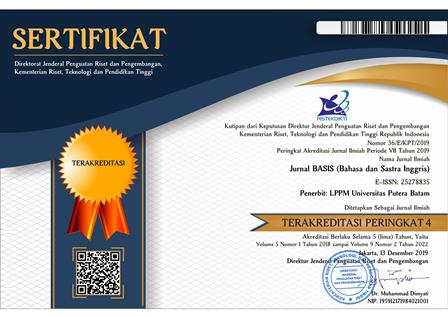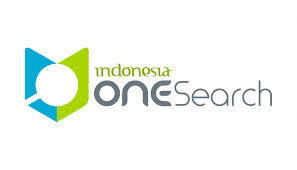THE EFFECTIVENESS OF SEMANTIC MAPPING AS PREWRITING ACTIVITY IN ARGUMENTATIVE WRITING
DOI:
https://doi.org/10.33884/basisupb.v6i1.1052Keywords:
Semantic Mapping, Prewriting Activity, Argumentative Writing, Writing AbilityAbstract
At present, the ability to write scientifically becomes an important skill mastered by students. Students need to have good writing skills using reasoning and logic that focuses on what must be believed or done based on mechanisms, such as doing conceptual analysis and arguments for problem solving and decision making. The concept of semantic mapping is an effective strategy to improve student writing skills. This study explores the effectiveness of the concept of semantic mapping in the development of students' writing skills in essay writing. This study was classified into a quasi-experimental design. In this study the population is students of Universal Batam University who are registered in the 2018-2019 academic year. The instrument of this research is a writing test. Data were analyzed with several analyzes, namely normality testing, homogeneity testing, and hypothesis testing. In testing the research hypothesis, the researcher used the t-test for the related sample and the Wilcoxon test. Based on the analysis it was found that the average score of students in the pre test was 7.89 and the average score of the students in the post test was 12. T-score count is t = 3.83 and a significant standard of 0.05. While t table is only 2,306. Because t count is greater than t table (tobserved> t table), so the null hypothesis (Ho) is rejected and the alternative hypothesis (Hi) is accepted. So, based on these results, it was concluded that there was a statistical difference between the pre-test at the 0.05 level. This means that learning argumentative writing based on the theory of semantic mapping has a significant influence on students' argumentative writing skills.
References
D, I. M. R. A. P. (2014). Employing Concept Mapping as a Pre-writing Strategy to Help EFL Learners Better Generate Argumentative Compositions Employing Concept Mapping as a Pre-writing Strategy to Help EFL, 8(2).
Dwyer, C. P., Hogan, M. J., & Stewart, I. (2015). The effects of argument mapping-infused critical thinking instruction on reflective judgement performance, 16, 11–26.
George Hilloks. (2011). Teacher Argument Mapping, Grade G-12 Support Claims with Relevant Evidence and Clear Reasoning. Los Angles: Heineman Educational Books.
Hasani, A. (2016). Enhancing argumentative writing skill through contextual teaching and learning, 11(16), 1573–1578. https://doi.org/10.5897/ERR2016.2806
Joan E Heimlich. (1986). Semantic Mapping: Classroom Application (Reads AIDS series).Los Angles.
K.J Peters. (2018). The Argument Hand Book. Canada: Broadview Press Ltd.
Katagall, R., Dadde, R., Goudar, R. H., & Rao, S. (2015). Concept Mapping in Education and Semantic Knowledge Representation : an Illustrative Survey. Procedia - Procedia Computer Science, 48(Iccc),638–643. https://doi.org/10.1016/j.procs.2015.04. 146
Leydesdorff, L., & Welbers, K. (2011). The semantic mapping of words and co- words in contexts. Journal of Informetrics,5(3),469–475. https://doi.org/10.1016/j.joi.2011.01.08
Liu, F., & Stapleton, P. (2014). Counterargumentation and the cultivation of critical thinking in argumentative writing : Investigating washback from a high-stakes test. System, 45, 117–128. https://doi.org/10.1016/j.system.2014.05.005
Ma, U. A., & Ma, M. Y. (2015). The Effect of Semantic Mapping Instruction on Iranian Undergraduate Students ’ Writing and Recall, 9(1), 21–29.
Nurcihan, Y. (2013). Using semantic mapping technique in vocabulary teaching at pre-intermediate level, 70, 1531–1544. https://doi.org/10.1016/j.sbspro.2013.01.221
Preiss, D. D., Castillo, J. C., Flotts, P., & Martín, E. S. (2013). Assessment of argumentative writing and critical thinking in higher education: Educational correlates andgenderdifferences.Learningand Individual Differences. https://doi.org/10.1016/j.lindif.2013.06.004
Scott, P., & Worden, R. (2012). Semantic mapping to simplify deployment of HL7 v3 Clinical Document Architecture. Journal of Biomedical Informatics, 45(4), 697–702. https://doi.org/10.1016/j.jbi.2012.02.006
Zahedi, Y., & Abdi, M. (2012). International Conference on Education and Educational Psychology ( ICEEPSY 2012 ) The effect of semantic mapping strategy on EFL learners’ vocabulary learning. Procedia - Social and Behavioral Sciences, 69(Iceepsy),2273–2280. https://doi.org/10.1016/j.sbspro.2012.12.198
Downloads
Published
Issue
Section
License

















